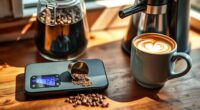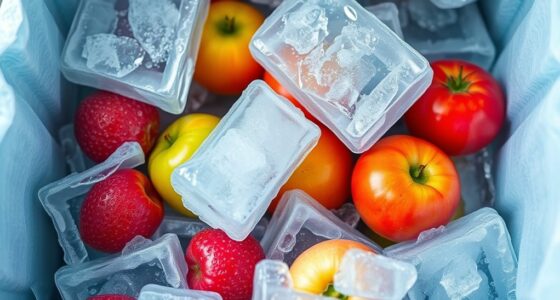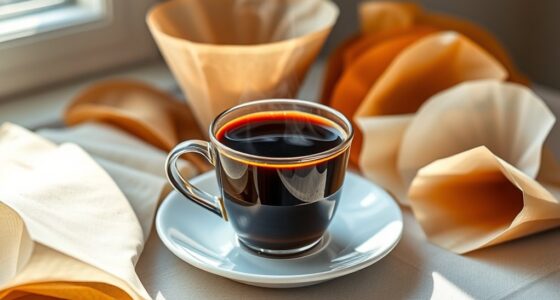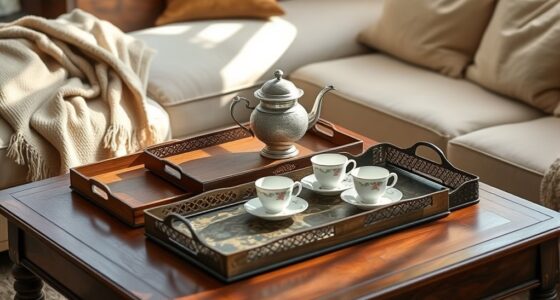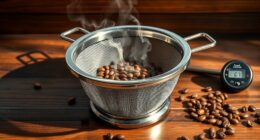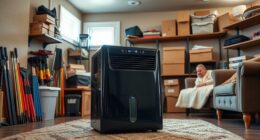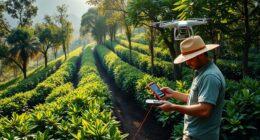To brew the perfect pour-over coffee, start with quality gear like a burr grinder and gooseneck kettle. Use a coffee-to-water ratio of 1:16 and monitor your brew time, aiming for 3-4 minutes. Adjust grind size if your coffee tastes sour or bitter. Pay attention to extracting phases like blooming, and always rinse filters for better flavor. With these tips, you’ll enhance your brewing skills even further. Keep going to discover more pro secrets!
Key Takeaways
- Use a quality burr grinder for a consistent medium grind size, similar to raw sugar, to enhance extraction.
- Measure coffee and water accurately using a kitchen scale, aiming for a coffee-to-water ratio of 1:16 for optimal flavor balance.
- Heat water to a precise temperature of 205-210°F to avoid bitterness and ensure smooth extraction.
- Pour in concentric circles during the blooming phase, saturating grounds evenly for better flavor clarity.
- Monitor total brew time, targeting 3 to 4 minutes to prevent under-extraction (sour) or over-extraction (bitter) flavors.
Essential Gear for Perfect Pour-Over
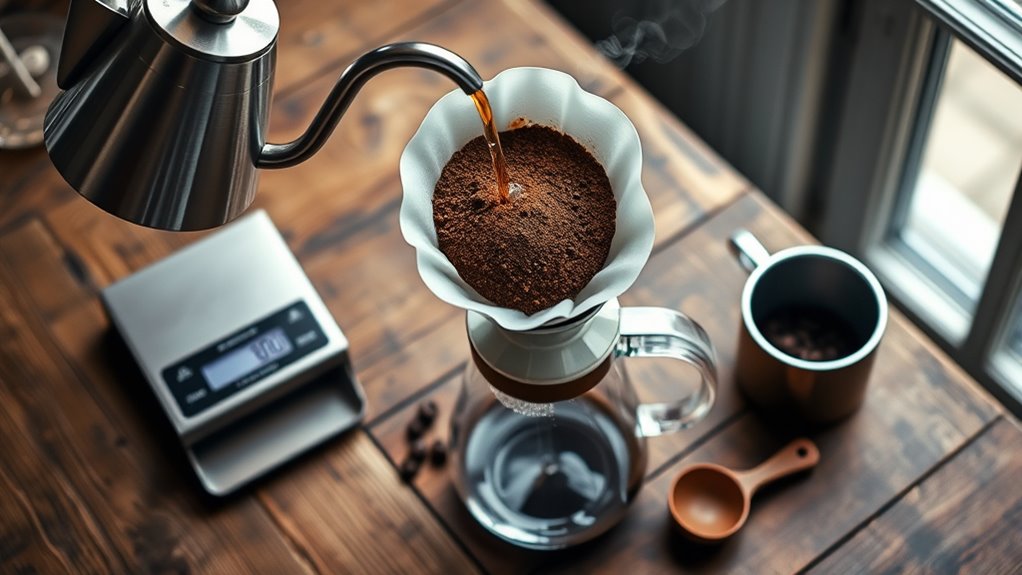
To brew the perfect pour-over coffee, having the right gear is vital. Start with a quality burr grinder, like the OXO Brew Conical Burr Grinder, to achieve a consistent grind size that enhances extraction and flavor.
Next, invest in a gooseneck kettle, such as the Fellow Stagg EKG, for precise pouring that guarantees even saturation of your coffee grounds. Don’t forget a kitchen scale to measure your coffee and water accurately; aim for a coffee-to-water ratio between 1:14 and 1:20 for ideal strength. Having a proper coffee-to-water ratio is crucial for achieving the desired flavor profile. Interestingly, studies suggest that even small adjustments in brewing methods can significantly affect the final taste of your coffee. Additionally, maintaining the right brewing temperature is essential for optimal extraction, as improper temperatures can lead to decreased efficiency in the brewing process.
For the brewing process, consider the Kalita Wave 185 for its forgiving design, or the Hario V60 for more clarity. Finally, use a timer, like the OXO Good Grips Triple Timer, to track each phase of extraction. Additionally, understanding the various brewing methods can help you refine your pour-over technique for optimal flavor.
Understanding the Pour-Over Process
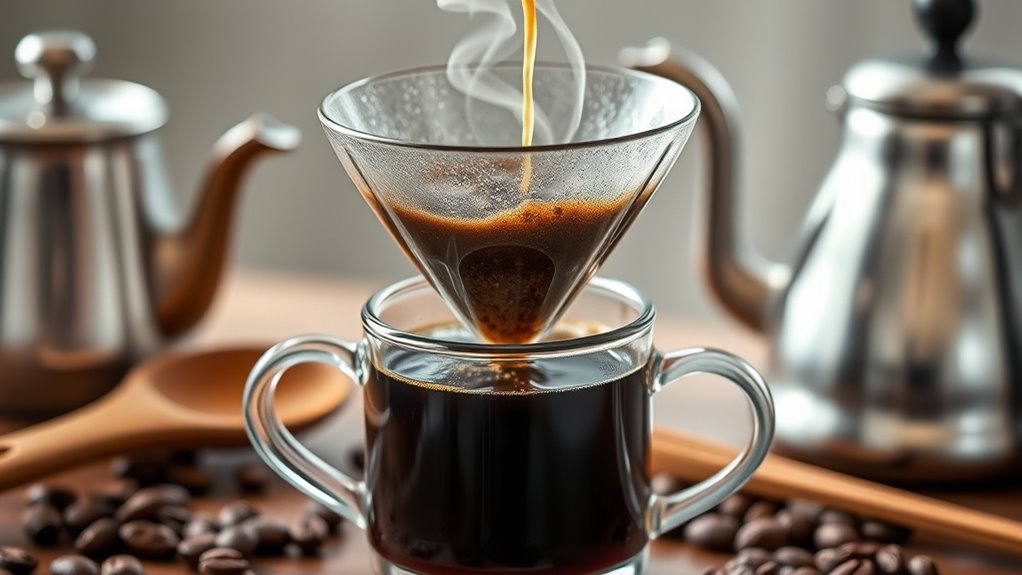
In this method, you manually pour hot water over coffee grounds, promoting continuous saturation for ideal flavor extraction. Pay attention to your coffee-to-water ratio; a range of 1:14 to 1:20 works well, with 1:17 being a great starting point for balanced flavors. Adjusting grind size, water temperature, and brew time also greatly influences your coffee’s profile. Using a gooseneck kettle allows for precise pouring, ensuring even extraction. Additionally, consider the caffeine content of your coffee beans, as it can vary significantly between different types and brewing methods. Embracing sustainable practices in sourcing your coffee can enhance both flavor and ethical consumption. Furthermore, the ideal steeping time for tea is crucial for achieving the best taste, similar to how brew time affects coffee flavor. Incorporating omega-3 content from sources like chia seeds into your diet can also positively influence your overall health, complementing your coffee experience. Investing in a high-quality air purifier can enhance your overall well-being by improving indoor air quality, making your coffee experience even more enjoyable.
Key Phases of Extraction
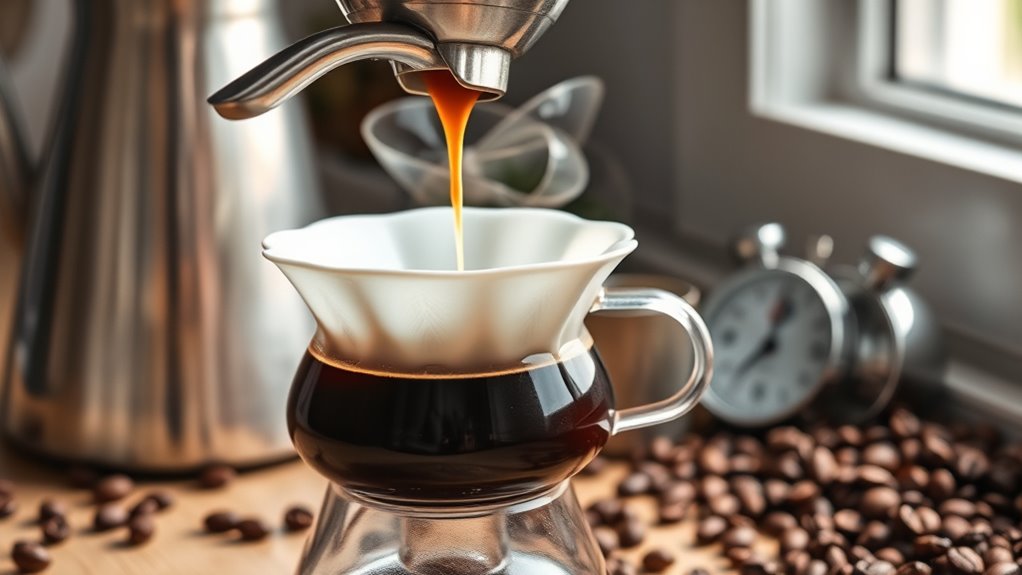
Understanding the key phases of extraction can greatly enhance your pour-over coffee experience. Each phase plays a crucial role in developing the flavor of your brew:
- Wetting: Hot water saturates the dry coffee grounds, prepping them for ideal extraction. Air purifiers can also enhance your overall coffee experience by ensuring a clean environment. Regular maintenance ensures that your air purifier operates efficiently, contributing to a better atmosphere for brewing. Additionally, using dark glass bottles to store your coffee beans can help maintain their freshness and flavor. Furthermore, using an air purifier with HEPA filtration can remove airborne particles that may affect the taste of your coffee.
- Blooming: As water is added, the grounds swell and release carbon dioxide, enhancing flavor clarity.
- Dissolution: This phase extracts soluble compounds, aiming for a balance of pleasant flavors while avoiding undesirable ones.
- Diffusion: Continuous water flow through the grounds, rather than immersion, influences the overall flavor profile of your coffee. Monitoring air quality indicators can also help maintain a pleasant brewing environment.
Incorporating whole foods into your breakfast routine can complement your coffee experience by providing essential nutrients and energy.
Variables That Influence Flavor

The flavor of your pour-over coffee is influenced by several key variables that work together during the brewing process.
First, the coffee-to-water ratio plays an essential role in flavor extraction; aim for a range of 1:14 to 1:20 to adjust strength. Effective wall organization can help create a more efficient and enjoyable coffee brewing station. Additionally, coffee contains antioxidants that can enhance your overall wellness, making the brewing process even more rewarding. Furthermore, certain coffee beans can offer health benefits that contribute to your well-being beyond just flavor. Incorporating natural elements into your brewing setup can improve the overall aesthetic and ambiance of your coffee experience.
Next, grind size impacts extraction rate—finer grinds speed it up, while coarser ones slow it down, affecting taste.
Brew time is also significant, ideally between 3 to 4 minutes; under-extraction can lead to sour notes, while over-extraction results in bitterness.
Maintain water temperature between 195°F and 205°F to avoid undesirable flavors.
Finally, gentle agitation, like stirring or swirling, promotes uniform saturation of the coffee grounds, enhancing overall flavor extraction. Additionally, maintaining the right coffee-to-water ratio can help ensure a balanced flavor profile that highlights the coffee’s unique characteristics.
Step-by-Step Brewing Guide

To brew the perfect pour-over coffee, start by gathering your materials and preparing your workspace. Follow these steps for a delightful final cup:
- Heat water to a precise brewing temperature of 205-210°F to avoid bitterness.
- Weigh your coffee, aiming for a 1:17 ratio for balanced flavor (e.g., 20 grams of coffee to 340 grams of water).
- Grind your beans to a medium consistency, resembling raw sugar, for even extraction.
- Begin by pouring twice the weight of coffee in water to bloom the grounds, then pour the remaining water in steady concentric circles, avoiding direct contact with the filter.
Aim for a total brew time of 3 to 4 minutes for ideal extraction. Enjoy your rich, flavorful coffee!
Importance of Brew Time and Grind Size
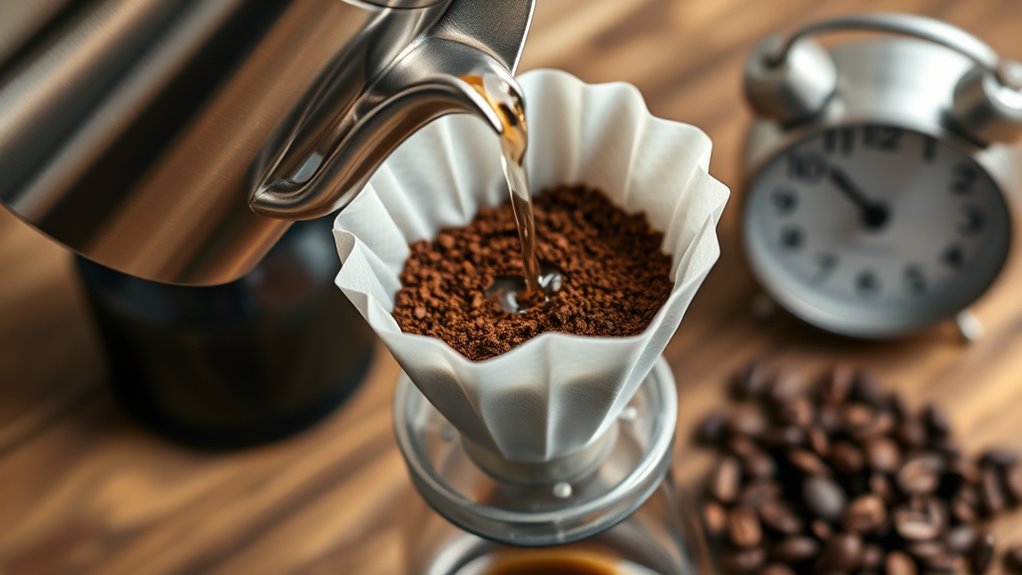
When brewing pour-over coffee, the right brew time and grind size can make all the difference in flavor. A shorter brew time with a finer grind can lead to under-extraction, while a coarser grind with a longer brew time might cause bitterness. Finding the perfect balance is key to achieving that delicious cup you’re after. Additionally, the caffeine content in coffee can significantly impact the flavor profile and overall experience of your brew. It’s also important to stay hydrated, as proper water intake can enhance your tasting experience. Freshly squeezed orange juice lasts 2-3 days when refrigerated, which is important to remember when enjoying your coffee alongside fresh juice.
Brew Time Impact
Understanding the impact of brew time on your pour-over coffee is fundamental for revealing the best flavors. The total brew time usually ranges from 3 to 4 minutes, and adjusting your grind size is important to achieve ideal extraction.
- A brew time under 2 minutes indicates your grind size might be too coarse.
- If your brew exceeds 5 minutes, the grind size is likely too fine.
- Pay attention to the bloom phase; timing here is essential for flavor balance.
- Consistent monitoring helps prevent under-extraction (sour taste) or over-extraction (bitter taste).
Grind Size Consistency
Achieving a consistent grind size is essential for getting the most out of your pour-over coffee, as it directly affects the extraction process and flavor profile.
A medium grind size, similar to raw sugar crystals, is ideal for pour-over methods, ensuring a brew time of 3 to 4 minutes. If your brew time is around 2 minutes, your grind is likely too coarse, while a brew time exceeding 5 minutes indicates it’s too fine.
To maintain uniformity, using a burr grinder is vital. This tool reduces the risk of under- or over-extraction, enabling you to refine your grind size based on taste.
Finer grinds can correct sour notes, while coarser grinds can mitigate bitterness, leading to a balanced cup.
Common Issues and Solutions
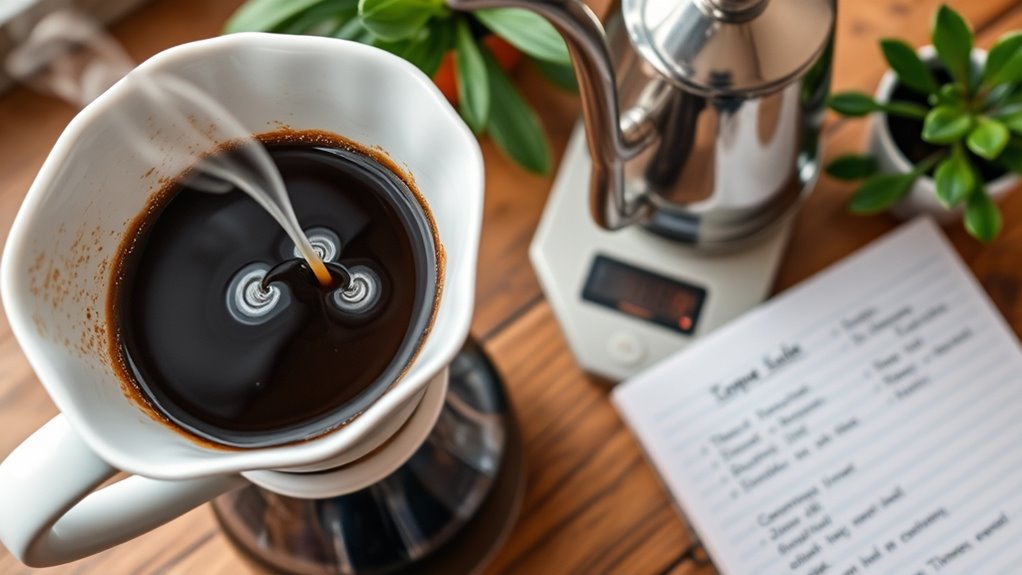
While brewing pour-over coffee can be a rewarding experience, you might encounter a few common issues that can affect your cup’s taste.
Here are some solutions to help you brew the perfect cup:
- Sour taste: Adjust the grind size to a finer setting to improve extraction.
- Bitter flavor: Use a coarser grind size to prevent over-extraction.
- Inconsistent brew times: Aim for a total brew time of about 3 to 4 minutes for ideal extraction.
- Papery taste: Rinse your filter with hot water before brewing to enhance flavor and warm the brewer.
Investing in a quality burr grinder can also guarantee a uniform grind size, making it easier to achieve consistent extraction in your pour-over coffee.
Flavor Evaluation Techniques

When you’re tasting your pour-over coffee, pay attention to the notes and how they change as the coffee cools.
Adjusting brew variables like grind size and water temperature can help you find the perfect balance of strength, sweetness, and bitterness.
Keeping track of these observations will sharpen your flavor evaluation skills and enhance your brewing experience.
Tasting Notes Analysis
Evaluating the flavors in your pour-over coffee can be an enjoyable journey, revealing the nuances that make each cup unique.
Focus on key attributes like strength, sweetness, acidity, and bitterness to enhance your tasting experience. Here are some tips to guide your analysis:
- Experiment with different coffee-to-water ratios, typically between 1:14 and 1:20.
- Use fresh, high-quality beans to reveal intricate flavors and aromas.
- Aim for an extraction point of 19-22% to guarantee balance.
- Keep a flavor journal to document your tasting notes and adjustments.
Adjusting Brew Variables
To achieve the perfect brew, you’ll want to adjust various variables that can considerably influence the flavor profile of your pour-over coffee.
Start by maintaining a consistent coffee-to-water ratio, ideally between 1:14 and 1:20, to balance strength and sweetness. If your coffee tastes sour, consider under-extraction; try a finer grind size or extend the brew time.
Conversely, a bitter taste suggests over-extraction, so switch to a coarser grind size or reduce the brew time. Don’t forget about water temperature, as it can affect extraction point, typically aiming for 19-22% of coffee mass.
Experimenting with different brew methods and pouring techniques can help reveal unique flavor notes, enhancing your overall coffee experience.
Tips for Consistency in Brewing
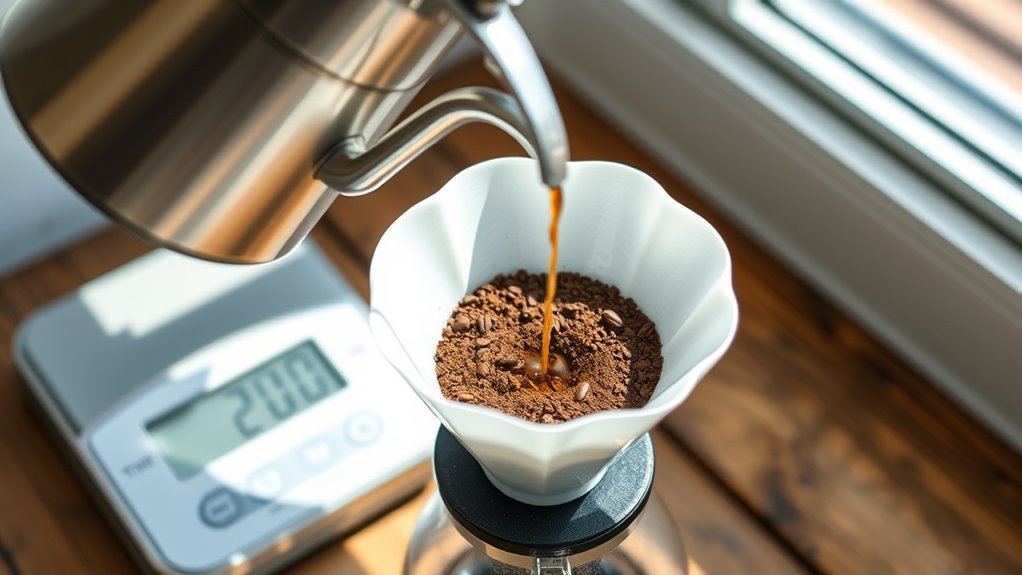
Achieving consistency in pour-over coffee brewing is essential for revealing the best flavors in your cup.
Consistency in pour-over coffee brewing is crucial for unlocking the rich flavors in every cup.
To guarantee you get it right every time, pay attention to these key factors:
- Maintain a consistent coffee-to-water ratio, typically around 1:16, for balanced flavor.
- Use a burr grinder to achieve uniform grind size, which impacts extraction.
- Monitor brew time closely, aiming for 3 to 4 minutes to prevent under- or over-extraction.
- Utilize a gooseneck kettle for controlled pouring, ensuring even saturation of coffee grounds.
Exploring Different Pour-Over Devices
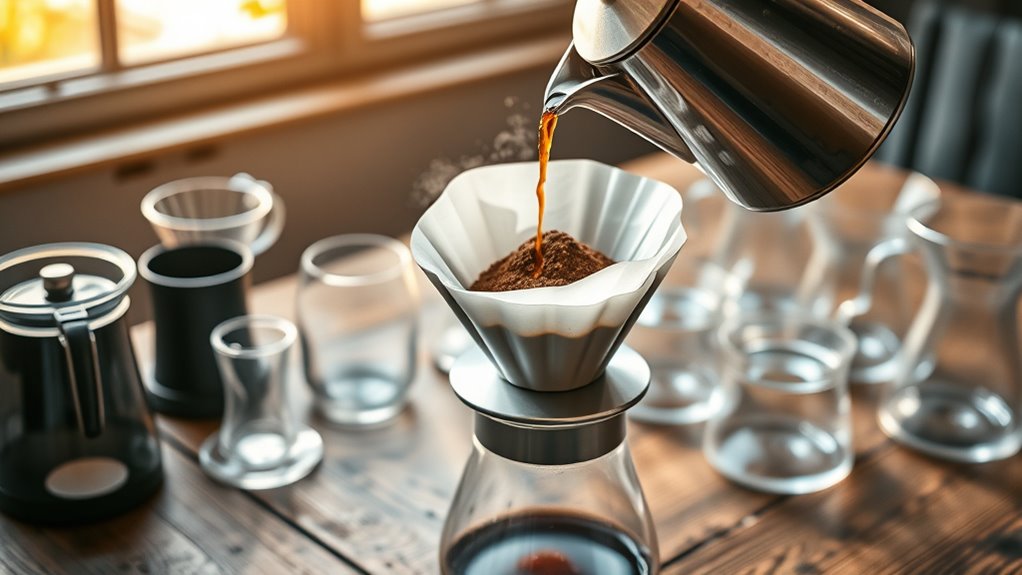
How do you choose the right pour-over device for your brewing style?
Consider the design and functionality of different pour-over devices. If you prefer consistency with minimal effort, the Kalita Wave is ideal, as its flat-bottom design promotes even extraction.
On the other hand, the Hario V60 offers advanced users control over brewing variables, enhancing the flavor profile through precise pouring techniques. Each device uses specific filters; the Kalita Wave requires unique wavy filters, while the Hario V60 can adapt to more widely available options.
For those looking to brew multiple servings, the Chemex Six Cup Classic Series is a great choice, known for its forgiving nature and thick filters.
Your choice should align with your brewing skill and coffee preferences.
Frequently Asked Questions
How to Make Pour Over Coffee Like a Pro?
To make pour-over coffee like a pro, start by heating your water to 205-210°F.
Measure 20 grams of coffee and 320 grams of water for a 1:16 ratio.
Pour 60 grams of water over the coffee to bloom for 30-45 seconds.
Then, slowly pour in a steady spiral, splitting the remaining water into two 130-gram pours.
Keep an eye on the brew time, aiming for 2:45 to 3:30 minutes for the best flavor.
What Is the 4 6 Method?
You might think brewing coffee is just about boiling water and tossing in grounds, right?
Well, the 4-6 method says otherwise. It’s a precise technique where you use four times the weight of water for blooming and six times for the final brew.
So if you’re using 20 grams of coffee, you’ll need 80 grams to bloom and then 120 grams to finish.
This method guarantees you’re really capturing those rich flavors.
What Is the Best Ratio for Pour Over Coffee?
The best ratio for pour-over coffee usually falls between 1:14 to 1:20, with 1:17 being a solid starting point.
If you’re aiming for a balanced brew, try using about 55-65 grams of coffee for every liter of water.
For example, 42 grams of coffee to 700 grams of water works well.
Remember, consistency in your ratio is key for achieving that perfect flavor every time you brew.
Adjust it based on your taste!
How to Get More Flavor From Pour Over Coffee?
Did you know that 60% of coffee’s flavor comes from proper brewing techniques?
To get more flavor from your pour-over, start by using a coffee-to-water ratio of 1:17. Grind your beans just before brewing for maximum freshness.
Bloom the coffee by adding double the weight of water to coffee, and maintain a water temperature between 195°F and 205°F.
Pour slowly in spirals to guarantee even saturation and enhance extraction for richer flavors.
Conclusion
You might think making pour-over coffee is too complicated, but it’s actually a rewarding experience that anyone can master. With the right gear and a little practice, you’ll enjoy rich, flavorful coffee that rivals your favorite café. Remember, it’s all about the process and fine-tuning your technique. So don’t shy away! Immerse yourself, experiment with different variables, and soon you’ll be brewing perfect cups that impress both you and your guests. Happy brewing!

